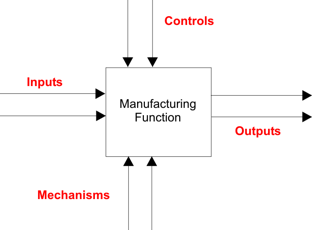
| DEX: (D001) product_breakdown_for_support — Product Breakdown for Support |
The ISO 10303-239 PLCS Application Activity Model (AAM) is an IDEF0 representation of the business activities that set the scope and information requirements for the PLCS standard. The model is composed of a set of figures and a set of definitions of these business activities and their associated information flows.
IDEFØ provides a graphical notation for function modeling of an organization or system. Activities can be described by their inputs, outputs, controls and mechanisms (ICOMs).

This DEX supports a subset of these business activities and information flows. These are highlighted in yellow in the figures Figure 11, Figure 2, Figure 3, and Figure 4.
The information flows marked with an asterisk are not explicitly represented within PLCS. This information is instead transferred by other means, e.g., handled by a document.
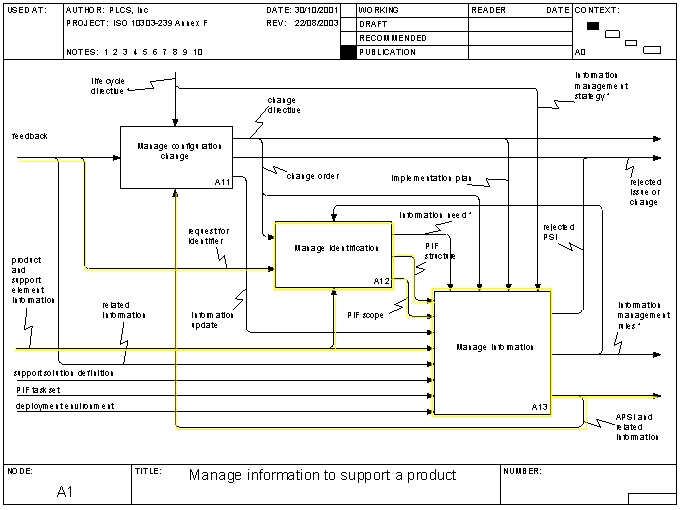
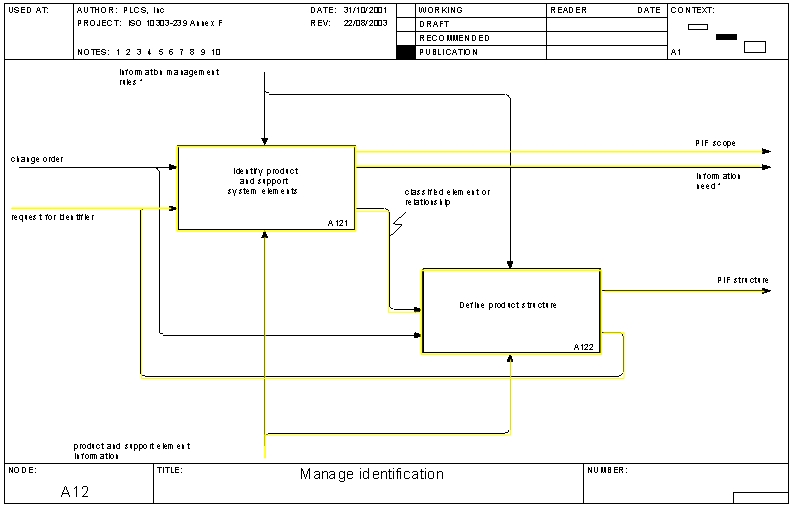
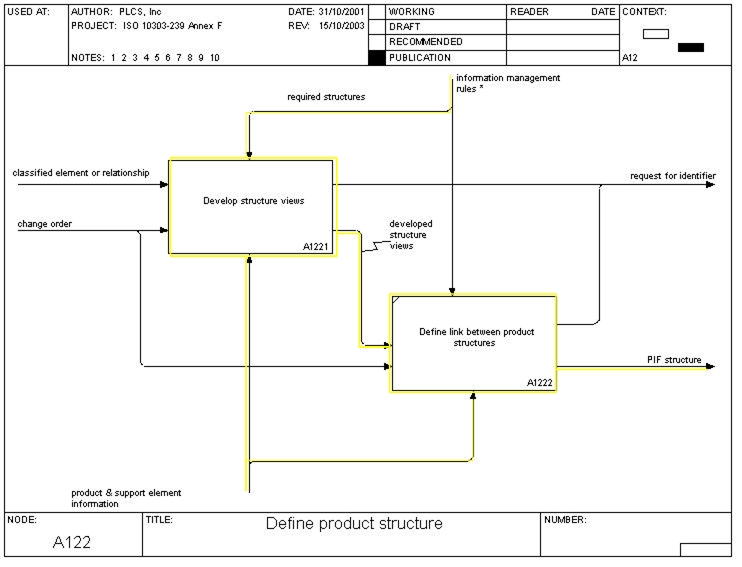
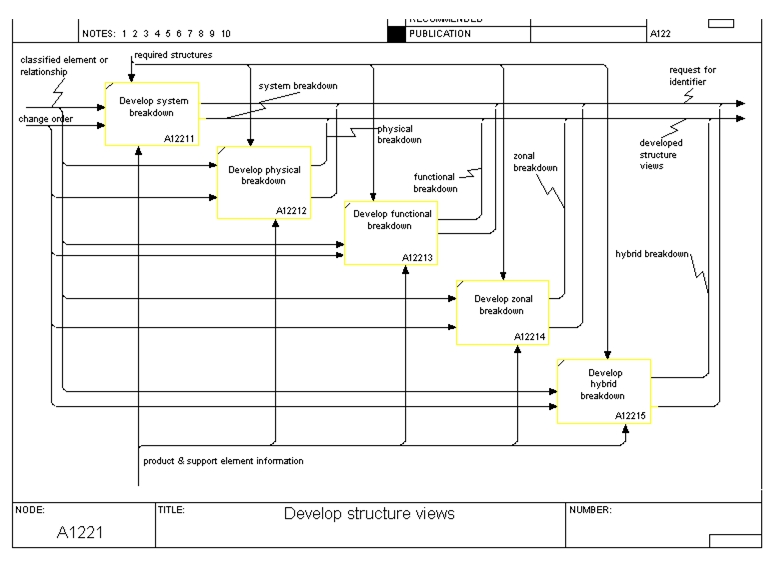
The activity labels in the AAM views above have the following definitions:
action to establish necessary links between different product breakdown views, reflecting relationships of interest
NOTE
Potential relationships include:
action to develop the required views of each relevant product, in the form of assembly structures or breakdowns built from classified elements and to establish necessary relationships between the different views to provide navigation between views
NOTE The managed set of product views (the PIF structure) provides unambiguous identification of the PIF for support management purposes and a key mechanism for navigating and managing the effectivity of all related information, including that specified by the information need providing the product definition and support solution.
action to develop a functional breakdown that is for the PIF scope and can act as a collector for product and support requirements and for other information relating to functional aspects of the PIF
NOTE Every element within a functional breakdown is a function. Design engineers can derive a functional breakdown from the systems breakdown and use it for managing related functional requirements and as an input to fault, hazard or failure analyses. Support engineers can use the same functional breakdown, or a modification of it, to identify functions that require support and to structure information on potential faults and symptoms.
action to establish the necessary breakdown views of the PIF by defining parent-child relationships between related elements
NOTE This part of ISO 10303 provides a generic mechanism for representing product assemblies or product breakdowns from any required perspective. A product assembly structure is usually developed by the engineering design process. This is used to define the parts and versions that make up the product and to develop a bill of material for product manufacture. Life cycle support activities will usually require the establishment of other product breakdown views. These views can include a decomposition of product functions from the operator or maintainer perspective and, in some cases, a zonal description of the product to assist maintenance planning. Each breakdown will contain similar classified elements, linked together in a hierarchical fashion.
action to develop a system breakdown that is for the PIF scope and can act as a collector for product and support requirements
NOTE
Requirements may be allocated to any assembly or breakdown type. Elements in a system breakdown can be:
action to provide both unambiguous identification and classification of all elements forming part of the PIF and its support system to which reference needs to be made, including interfaces and other relationships between such elements to which configuration management shall apply
NOTE Classification of elements and interfaces can be used to assist in defining information needs.
action to provide both unambiguous identification and classification of all elements forming part of the PIF and its support system to which reference needs to be made, including interfaces and other relationships between such elements to which configuration management shall apply
NOTE Classification of elements and interfaces can be used to assist in defining information needs.
action to provide unambiguous identification of all elements, and versions, of the product or support system to which reference needs to be made, identification of interfaces between elements, the necessary assembly, and other breakdowns structures, required to manage the product through life and definition of the information to be held for each type of product and support system element
NOTE
This activity occurs throughout the product life cycle and is the basis of management of configuration change and configuration status accounting of a product and all constituent configuration items. The purposes and benefits of this activity include:
action to manage the information related to a PIF
NOTE This activity corresponds to configuration and data management and the major output is APSI, which encompasses the entire configuration and support data. A subset of the APSI is the configuration status record. The dynamic nature of the configuration and data management activity, and its importance within the operation of a consistent configuration management process throughout the product life cycle requires a formal approval process to attain APSI status. All configuration documentation (requirements and design documentation) and associated operational information (operating procedures, parts catalogues, and so on) that comprise the configuration status record must be formally managed and approved. In essence, approve, release and record is a process that makes configuration and support documentation available for use, subjects it to configuration change management and maintains the assured status of the APSI.
The ICOM arrow labels in the AAM views above have the following definitions:
set of assured and related information used to develop and deliver support for a product in focus, including feedback from using and supporting the product over its life cycle
NOTE Related information includes records of the history of the usage or support of realized products, design and support analysis results and reasons why decisions were taken. Such information includes design and failure analysis records, logistic support analyses, running hours, environment descriptions, operating profiles; test results, records of maintenance activities, resources used, and faults found plus any other content deemed relevant to life cycle support.
element of the PIF or its support system and that has been identified and assigned to one or more classes of element, plus any relationships between elements needing to be tracked for support purposes
NOTE Unambiguous identification includes the assignment of a name (for use by humans) and an alphanumeric identifier (for use within computers) that are unique within a context. The context for a name or identifier is the organization that provides the name and identification. Elements can have more than one name and identifier assigned by different organizations. The classification of an element can include a class that helps identify the APSI that is required for this element type. Relationships can include any of those specified by the information model of this part of ISO 10303.
set of product structure views and breakdowns that the life cycle owner has chosen to establish and maintain for the life of the PIF
hierarchical decomposition of the functions of a product
NOTE The functional breakdown elements can require support.
specification of the information that shall be developed and maintained within the APSI for any PIF or support system element or class of elements
identification of the group of actual or potential operational products and related items that require support during their life cycle
NOTE
The PIF scope can include:
integrated set of classified elements and interfaces, product structure views and relationships between product structure views required to provide life cycle support
NOTE
The PIF structure comprises:
integrated set of classified elements and interfaces, product structure views and relationships between product structure views required to provide life cycle support
NOTE
The PIF structure comprises:
any information about the product in focus and related support elements that is required by participants in life cycle support
NOTE
This information may include:
request to provide identification for new elements of the product or support system element
NOTE Requests may arise from new product concepts, developing breakdowns of existing products, or from changes.
set of product assembly or breakdown views that the life cycle owner requires to establish and maintain the PIF
© OASIS 2010 — All rights reserved